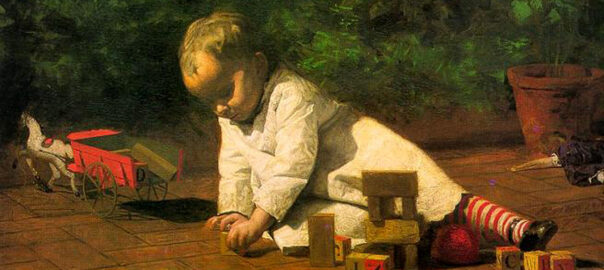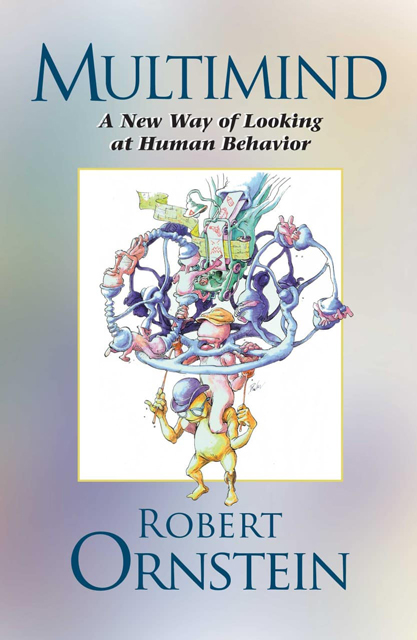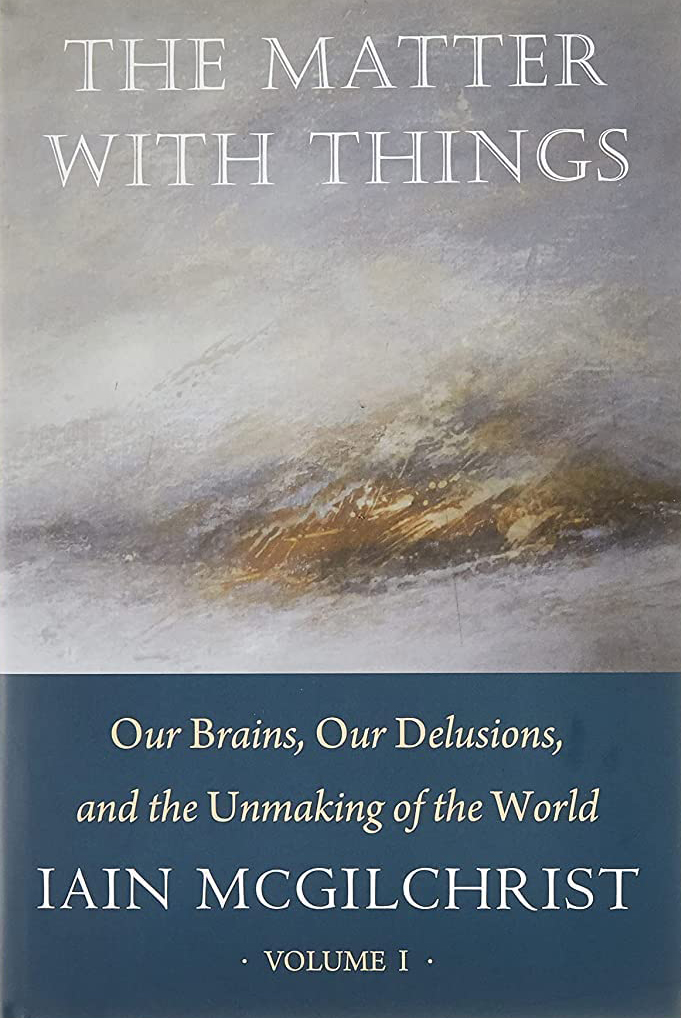
Unconscious Associations
Thomas Eakins, Wikimedia Commons
Some unconscious connections aren’t just metaphorical but are grounded in how we perceive and interact with our world. We automatically associate “high” with good—and, of course, “good” with “God.”
The content of this section, unless indicated, represents Robert Ornstein’s award-winning Psychology of Evolution Trilogy (God 4.0, The Evolution of Consciousness and The Psychology of Consciousness) and Multimind. It is reproduced here by kind permission of the Estate of Robert Ornstein.
Very early in childhood, before language abilities or memory retrieval skills appear, the infant learns about the physical world (e.g., distance, size, temperature) through direct concrete experiences.
These physical experiences become associated with the infant’s emotional experience at the time. John Bowlby in his book Attachment and Loss found that the need for both physical and social warmth across evolutionary time periods has resulted in an innate drive for the young of many species, including humans, to remain close to their parents and kin.
Early childhood experiences with caretakers who provide warmth—both physical (holding close) and psychological (love, trust, help, support)—lead to the development of a strong associative connection between our perceptions of physical and social warmth. This explains why we so easily and fluently use physical terms to refer to and describe more abstract phenomena—especially social and psychological phenomena, as in a “close” relationship, a “warm” smile, or a “cold” shoulder.
A Nice Cup of Tea
Holding a cup of warm coffee or tea results in behavior that is more selfless and generous than when holding a cold or iced drink.
Studies show that physical and social warmth are inextricably linked and, because they are part of our self-regulatory system, affect our behavior unconsciously. Experiencing physical warmth like warm baths or showers or a warm drink will help to fight off loneliness or rejection. Such incidental warmth experiences produce in turn “warm” psychological experiences of trust and affect our behaviors, such as generosity, without our awareness.
Holding a cup of warm coffee or tea results in behavior that is more selfless and generous than when holding a cold or iced drink. When studies took place in either a cold or warm room, those participants in the warmer room reported feeling interpersonally closer to the experimenter than those in the colder room. Across all the studies, physical warmth led to judgments and behavior that were socially warm and the reverse.
God Is Watching
Reminders that “God is watching” are everywhere in our society and often go unnoticed. And yet, they unconsciously influence our behavior. The watchful eye of God is often depicted in the stained-glass windows of churches. People in the US may still have reminders in their pockets or purses, as the phrase “In God we trust” is printed on US paper currency, and some denominations also include that watchful eye looking right at the bearer—and floating atop a pyramid.
An ever-watching god-figure might also have been instituted to deter people from cheating, which would have been an important adaptation as we formed societies that relied on cooperation. In one study, undergraduates were asked to complete a computerized spatial intelligence test, but were told that because there were still glitches in the system, occasionally the answer to a question they were asked might accidentally pop up on the screen (of course, the popups were deliberate). If that happened, the students were supposed to press the space bar immediately to clear it.
Before beginning the test, some of the undergraduates were told a ghost story about a student involved in the study who died suddenly and whose ghost had been recently seen in the testing room. The researchers found that these participants resisted the opportunity to cheat by pressing the space bar more quickly than those who merely saw, at the end of the instructions, that the test was dedicated to a student who died, or who were told nothing at all.
All of these studies depend on “theory of mind,” which is our tendency to suppose that others (even dead others) have minds and intentions. There doesn’t even have to be a supernatural or ghostly element involved; the same effect can be triggered by an image of a pair of (watching) eyes. Professor Melissa Bateson and her colleagues carried out a now famous experiment in the psychology department lounge at England’s Newcastle University. They displayed images of eyes or flowers next to the “honesty box” for coffee contributions. In all, 48 people were involved in the ten-week study.
The notice placed above the coffee/tea-making equipment gave the instructions for payment and prices, and included a banner at the top. On alternate weeks, the banner depicted either eyes or flowers, with the specific eyes and flowers also varying weekly. Because of the layout of the lounge, it was unlikely that anyone would notice if someone did or did not feed the honesty box. Yet the eye images had a large effect, with contributions almost three times as high during weeks when eyes were displayed than when flowers were displayed. Which eyes—blue, brown, hazel, round- or almond-shaped—and which flowers proved to be irrelevant.
However, only a small group of people used these facilities every day, and everyone knew the person who ran the coffee fund. Would the “eye effect” be as strong when similar posters were used in more anonymous places with a higher volume of traffic? Also, even though the notices seemed to be prominently placed, was it possible that the eyes had drawn extra attention to them, thus accounting for the results?
To answer these questions, the researchers used a university cafeteria that served many hundreds of people a day, most of them not known to each other or to the cafeteria staff. There were four scenarios: eyes at the top of a poster asking people to put trays in the racks provided after finishing their meal, or at the top of a poster telling people they could eat only food or drink purchased on the premises; and these same two posters, but with flowers instead of eyes. The researchers found that more people cleared their tables when there were eyes present on a poster, regardless of the poster’s message.
Up and Down
Our personal understanding of “up” and “down” all develop from infancy. We grow “up” in a world where the sky above is limitless and is often filled with light, but the ground below is close, sometimes dirty, and can contain threats. People of authority are always higher than we are as children, and we literally and metaphorically “look up” to them.
The ability to see upward and beyond ourselves has become connected in all cultures with what is positive and good. Good things get a thumbs-up, while bad things get a thumbs-down. We talk approvingly of people being farsighted, upwardly mobile, upstanding, high-minded and uplifted. We climb up the ladder, aim high, hit the top spot, ascend the organizational chart and rise to the pinnacle of success.
When we are babies, we are literally down, and everything is above us; later on in life, being down becomes associated with dependence, inferiority (low in status), and helplessness. We even say “I’m down today” when feeling sad. Just as “up” is about control, “down” is about being controlled, subjected, subdued. As a baby learns to stand, falling down is about failure. Metaphorically, we refer to problems in contractual negotiations as “stumbling blocks,” refer to shaky governments as “tottering,” and so on. We sink under burdens, drop our standards, become downcast and downtrodden, receive low blows, hit below the belt, reach rock bottom, and plumb the depths of despair. And when we are depressed, we are not only down but turned inward.
Many important religious events involve ascension and/or elevation. A significant event in Christian theology is the Transfiguration when Jesus speaks to the spirits of Elijah and Moses on a mountaintop; in the highly significant Night Journey, Muhammad is lifted into the sky on a mythical winged horse to visit Jerusalem and then Heaven. Jesus is depicted high on the cross when he’s crucified on a hill outside Jerusalem’s city walls; angels seem to inhabit upper space, whence they may fly down to Earth for particular purposes.
The Egyptians revered astronomer-priests; and their pyramids, pointing high into the sky, had both astronomical and religious significance; Mesopotamia’s massive ziggurats connected heaven and earth, each providing a temporal dwelling for the city’s patron god. Buildings across all religions, including major mosques, temples and cathedrals, extend into the sky; and monasteries tend to be built on mountainsides and hilltops rather than in valleys. Even famous mountains throughout the world, such as Fuji, Kilimanjaro, Olympus, Sinai and Shasta, have been imbued with sacred properties; and military pilots and astronauts sometimes claim to sense or experience God when flying.
Conversely, negative concepts in religion—most notably Hell, Hades—have “downward” connotations. When we are prone or supine, we are helpless, worthless. Snakes, wriggling along on the ground, are often associated with evil in the Bible and are viewed as harmful in real life.
Shadowy creatures that inhabit the darkness, such as bats, have a negative image. Even darkness itself (more prevalent in lower space) is usually represented negatively, as a cover for villains and thieves.
Higher Is Better
Psychologists have shown that these sorts of unconscious connections aren’t just metaphorical but are grounded in how we perceive and interact with our world. When we refer to our own person, the expression “below the belt” is often used to describe not only unfair experiences, but also things that are hurtful, naughty, dirty, or even dangerous. Below the belt is where there’s not only the unclean waste that we need to get clear of, but also the sexual impulses that can lead to conflict and disease as well as fun and family. So growing up, seeing the sky above, the Earth below and the dangers below that—including insects and snakes—leads to a “higher is better” sensibility. In religion, “further down” easily becomes associated with Hell, the Inferno or Hades.
We even think things are more important and significant, and “better,” if they are displayed higher rather than lower. This is true in even on computer screens. People more quickly identify a word as positive if it is presented in a high position on a screen, while the reverse is true for words identified as negative. Seeing things generally as more positive, more desirable and better when presented to us higher up is part of the way our brains are constructed. We automatically associate “high” with good—and, of course, “good” with “God.”
The connection between looking down and despairing is not metaphorical, either. The more neurotic or depressed people were found to be, the quicker they were at detecting targets presented in the lower part of a computer screen.
Since “up” is related to perception of power, it would seem to make sense that there would be an upward bias in societies with dominant religions involving an Almighty. Brian Meier of Gettysburg College in Pennsylvania, and his team, set out to discover whether the common linking of “high” with God and “low” with the Devil merely represent metaphors that aid communication or are indicative of something deeper: the way our brain categorizes and stores information (the latter being their hunch).
They devised experiments to find out. First, they determined whether people implicitly associated “up” with God and “down” with the Devil. They found that people with a stronger personal belief in God showed a stronger tendency toward this association. Participants were faster at recognizing the words when God-related words were presented higher on the computer screen and Devil-related words lower. They also remembered the God-images as being presented higher on the screen and the Devil-images being lower on the screen than they actually were, with neutral images showing no such bias.
Further studies explored whether people thought strangers, whose images randomly flashed up at the top or bottom of a screen, believed in God or not. The higher up on the screen the faces were presented, the more likely their owners were deemed to be strong believers.
Meier and colleagues concluded, “…we obtained results that are consistent …with the …idea that representation of the divine versus profane ‘borrows’ from the vertical domain of perception.”
The same neurological underpinnings that ensured we understood our universe as a three-tiered cosmos—the heaven above, the earth on which we stand and the underworld below—afforded a basis for all our unconscious associations. They, our social development, our group solidarity, and our ability to connect to an ever-expanding community of “us,” all provided the scaffolding upon which a capacity for higher consciousness became possible.

Multimind: A New Way of Looking at Human Behavior
Robert E. Ornstein
This provocative book challenges the most-popularly held conceptions of who we are. In it, psychologist and renowned brain expert Robert Ornstein (1942 – 2018) shows that, contrary to popular and deep-rooted belief, the human mind is not one unified entity but, rather, is multiple in nature and is designed to carry out various programs at the same time.

The Matter with Things
Iain McGilchrist
In his masterly two-volume exploration of our brain hemispheres, Iain McGilchrist argues that in order to understand ourselves, the world and the universe, we need a combination of the right and left hemispheres working in tandem, but with the right brain leading the way.

Beyond Culture:
Edward T. Hall and Our Hidden Culture
Report by John Zada
Edward T. Hall, after spending his early adulthood working and travelling among non-Anglophones, both in the United States and in other parts of the world, became cognizant and fascinated in the deeper layers of culture that he claimed lie buried beneath those more obvious forms.
In the series: Our Mind in the Modern World
- An Ancient Brain in a Modern World
- Our Unconscious Minds
- Maintaining a Stable World
- The Multiple Nature of Our Mind
- Connecting with Others
- Morality’s Long Evolution
- The Brain’s Latent Capacities
- God 4.0
- Multimind: A New Way of Looking at Human Behavior
- Thinking Big
- Social
- The WEIRDest People in the World
- The Righteous Mind
- New World New Mind
- Moral Tribes
- The Mountain People
- The Matter with Things
- Humanity on a Tightrope
- Fluke by Brian Klaas
- Beyond Culture
- Think Again
